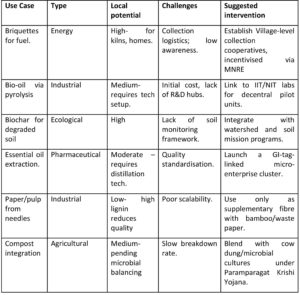Pine needles have their uses
Editor,
The special article “Ecological Dynamics and Biogeochemical Impacts of Pine Forest Expansion” by Kitlang Donbor Kharkongor (ST August 2, 2025) made interesting reading. The Ex-District Agriculture Officer has made an excellent presentation of the ecological and resilience dynamics between pine forest and native broadleaf ecosystems and the impact on the environment in Meghalaya. He has rightly concluded that “the Government of Meghalaya must implement immediate policy intervention prioritising hardwood forest restoration and sustainable land use planning.” A comparative framework of pine needles vs. native broadleaf system in Meghalaya below serves as a good illustration:

In the immediate future we cannot do away with pine forests that exist in Meghalaya but we need to make use of the pine needles. A Feasibility study of pine needles as a potential source of bio-energy by scholars of G.P. Pant University of Agriculture and Technology, Uttarakhand states that “the Himalayan region suffers a lot from seasonal power shortages due to poor electrical infrastructure and transmission. The conventional methods (direct burning of fuel and wood) are highly practiced in these regions. Pine needles have great potential for conversion into fuel due to their high calorific value as compared to other biomass. There are several ways for thermochemical conversion of pine needle biomass into fuel; the biomass can be directly used for electricity generation, used in with-binder or binder-less briquetting, pyrolysis and gasification. The end products of thermochemical conversion (pyrolysis, liquefaction and gasification) processes are bio-oil, bio-char and producer gas.” A policy and mapping framework around pine needle utilisation is the need given the pine needle proliferation. Application matrix below:

The feasibility study by the scholars of G.P. Pant University of Agriculture and Technology, Uttarakhand referred to above concludes that pine needles are a suitable precursor for bio-energy production through thermo-chemical conversion.
Yours etc;
VK Lyngdoh,
Via email
Unity is Good, But Democracy Needs More Than One Voice
Editor,
When Meghalaya’s Deputy Chief Minister and NPP State President Prestone Tynsong says, “We have enough room for all 60 MLAs,” it sounds warm and welcoming. And who does not want unity? Who does not wish for peace and progress? But let us pause and think: is a legislature with no opposition really progress or a warning? Development is important. No one denies that. But development without debate, without questions, without accountability, can easily become one-sided. A government that faces no challenge may begin to believe it makes no mistakes. And that is where the danger begins.
The NPP’s open invitation to all MLAs on the condition that they support “development” may sound noble. But what does that really mean? Is “development” now the only acceptable political belief? Are we saying that anyone who asks questions, who demands answers, or who offers a different idea is somehow against progress? That cannot be the spirit of a democracy. The opposition is not an enemy. It is a part of the system. It is not there to create trouble; it is there to prevent trouble. It checks spending. It questions decisions. It reminds power that it must answer to the people. Remove the opposition, and you do not have unity. You have silence.
And now, we hear that “Meghalaya need not spend crores building a State Assembly.”
With all respect, this is troubling. The Assembly is not just a building. It is a symbol of democracy. It is where laws are made, where ministers are held accountable, and where elected representatives speak for their people. Should such a space be dismissed because one party feels strong today?
A strong government does not fear debate. A confident democracy does not cancel its classroom just because everyone seems to agree. Let us also remember: the Constitution gives us a system of balance. It allows for a ruling party—but also for a strong, active opposition. That balance is not outdated. It is essential. Yes, political stability is good. But stability built on merging parties, offering positions, and absorbing MLAs into one-fold without real public mandate does not strengthen institutions. It weakens them. It turns elected representatives into party loyalists first, and public servants second.
And what happens to those who disagree? Are they left out? Are they seen as obstacles? We must be honest: one-party dominance, even with a smile, is still dominance. And when no one dares to say “wait, let’s think again,” democracy begins to sleep.
We do not question the NPP’s right to govern. We do not doubt their desire to develop Meghalaya. But we do ask: can development truly thrive without space for different voices? Can progress be real if no one is allowed to question how it is being done?
And let us not build a future where only one party speaks, for the day may come when no one else is left to listen. Let us choose not just development but democracy with depth. Let us welcome unity but never at the cost of our right to ask, to question, and to choose. Because a healthy state is not one where everyone agrees. It is one where every voice, even the one that disagrees, is heard.
Yours etc.,
Marbiang Rymbai
Observer of Northeast Politics & Education Policy
Via email



